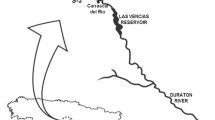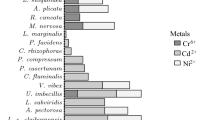Abstract
The influence of increased fluoride concentrations generated by a wastewater treatment plant on the spatial distribution and abundance of benthic larvae of Hydropsychidae (Insecta, Trichoptera) species in the Cache la Poudre River (Colorado) was examined. Acute lethal concentrations of fluoride ion (F−) to these species were determined in soft water (average value of hardness 40.2 mg CaCO3/L) by static toxicity bioassays. The wastewater treatment plant caused a significant (P<0.05) increase in the fluoride concentration at three downstream sampling sites (mean values 1.17, 0.84, and 0.56 mg F−/L at 0.1, 1.6, and 9.2 km downstream sites, respectively) compared with the upstream reference station (0.31 mg F−/L). The 48, 72, 96, 120, and 144-h LC50s (mg F−/L) were 52.6, 25.8, 17.0, 13.4, and 11.5 for Hydropsyche bronta Ross, 102.0, 53.5, 34.7, 27.0, and 21.4 for Hydropsyche occidentalis Banks, and 128.0, 73.2, 42.5, 31.9, and 24.2 for Cheumatopsyche pettiti (Banks). LC50 values for H. bronta were significantly (P<0.05) lower than LC50 values for the other two test species. Abundance and biomass of all hydropsychid species were significantly (P<0.05) lower at the 0.1 km downstream site than at the upstream reference site. H. occidentalis was usually the most abundant species at the reference and 9.2 km downstream stations, with highest abundances at the 9.2 km downstream site. C. pettiti was dominant at 0.1 and 1.6 km downstream sites, showing higher abundances at the 1.6 km downstream site than at the upstream reference site. H. bronta was never collected at 0.1 and 1.6 km downstream sites, but was abundant at the upstream reference site. It is concluded that the fluoride pollution is not a major factor in determining the spatial distribution and abundance of competing hydropsychid species in the Cache la Poudre River. However, the greater sensitivity of H. bronta larvae to fluoride ions could result in decreased abundances of this species at downstream sampling sites.
Similar content being viewed by others
References
American Public Health Association (1989) Standard Methods for the Examination of Water and Wastewater, 17th ed. APHA-AWWA-WPCF, Washington, DC
Angelovic JW, Sigler WF, Neuhold JM (1961) Temperature and fluorosis in rainbow trout. J Water Pollut Control Fed 33:371–381
Boyd WL, Martin KL, Warbington RC, Fausch KD (1986) Cache la Poudre River Survey 1985. Colorado State University, Fort Collins, CO, 198 pp
Britton LJ, Goddard KE, Brigs JC (1983) Quality of rivers of the United States, 1976 water year—based on the Natural Stream Quality Accounting Network (NASQAN). US Geol Surv Open-File Rept. 80-594, Reston, VA, 423 pp
Camargo JA (1989) Estudio ecotoxicológico del impacto ambiental generado por una regulación de caudales y un vertido de flúor, sobre las comunidades de animales acuáticos del Río Duratón. PhD Dissertation, Madrid Autonomous University, Madrid, Spain
— (1991) Toxic effects of residual chlorine on larvae of Hydropsyche pellucidula (Trichoptera, Hydropsychidae): A proposal of biological indicator. Bull Environ Contam Toxicol 47:261–265
Camargo JA, Tarazona JV (1990) Acute toxicity to freshwater benthic macroinvertebrates of fluoride ion (F−) in soft water. Bull Environ Contam Toxicol 45:883–887
—, — (1991) Short-term toxicity of fluoride ion (F−) water to rainbow trout and brown trout. Chemosphere 22:605–611
Cummins KW (1975) Macroinvertebrates. In: Whitton BA (ed) River ecology. Blackwell Scientific Publications, Oxford, pp 170–198
Dave G (1984) Effects of fluoride on growth, reproduction and survival in Daphnia magna. Comp Biochem Physiol 78C:425–431
Dobbs GG (1974) Fluoride and the environment. Fluoride 7:123–135
Elston RC, Johnson WD (1987) Essentials of biostatistics. FA Davis, Philadelphia, 307 pp
Giesy JP, Graney RL (1989) Recent developments in and intercomparisons of acute and chronic bioassays and bioindicators. Hydrobiologia 188/189:21–60
Hemens J, Warwick RJ (1972) The effects of fluoride on estuarine organisms. Water Res 6:1301–1308
Henny CJ, Burke PM (1990) Fluoride accumulation and bone strength in wild black-crowned night-herons. Arch Environ Contam Toxicol 19:132–137
Hildrew AG, Edington JM (1979) Factors facilitating the coexistence of hydropsychid caddis larvae in the same river system. J Anim Ecol 48:557–576
Komnick H (1977) Chloride cells and chloride epithelia of aquatic insects. Int Rev Cytol 49:285–329
Lapchin L, Neveu A (1979) Ecologie des pricipaux invertebres filtreurs de la basse nivelle (Pyrenees-Atlantiques). II—Hydrop sychidae (Trichoptera). Ann Limnol 15:139–153
Le Blanc G (1980) Acute toxicity of priority pollutants to water flea (Daphnia magna). Bull Environ Contam Toxicol 24:684–691
Litchfield JT, Wilcoxon F (1949) A simplified method of evaluating dose-effect experiments. J Pharmacol Exp Ther 96:99–113
Martin JM, Salvadori F (1983) Fluoride pollution in French rivers and estuaries. Estuarine Coastal Shelf Sci 17:231–242
McClurg TP (1984) Effects of fluoride, cadmium and mercury on the estuarine prawn Penaeus indicus. Water SA 10:40–45
Nuske H, Wichard W (1972) Die analpapillen der köcherfliegenlarven. II—Feinstruktur des ionentransportierenden undrespiratorischen epithels bei Glossosomatidae. Cytobiologie 6:243–249
Oliveira L, Antia NJ, Bisalputra T (1978) Culture studies on the effects from fluoride pollution on the growth of marine phytoplankters. J Fish Res Board Can 35:1500–1504
Pillai KS, Mane UH (1984) Effect of F- effluent on some metabolites and minerals in fry of Catla catla. Fluoride 17:224–233
Pimentel R, Bulkley RV (1983) Influence of water hardness on fluoride toxicity to rainbow trout. Environ Toxicol Chem 2:381–386
Schefter PW, Wiggins GB (1986) A systematic study of the Nearctic larvae of the Hydropsyche morosa group (Trichoptera: Hydropsychidae). Royal Ontario Museum Publications, Toronto
Schuster GA, Etnier DA (1978) A manual for the identification of the larvae of the caddisfly genera Hydropsyche Pictet and Symphitopsyche Ulmer in Eastern and Central North America (Trichoptera: Hydropsychidae). US EPA 600/4-78-060, Washington, DC
Sigler WF, Neuhold JM (1972) Fluoride intoxication in fish: A review. J Wildl Dis 8:252–254
Smith LR, Holsen TM, Ibay NC, Block RM, De Leon AB (1985) Studies on the acute toxicity of fluoride ion to stickleback, fathead minnow and rainbow trout. Chemosphere 14:1383–1389
US Environmental Protection Agency (1986) Quality criteria for water. EPA 440/5-86-001, Washington, DC
Wiggins GB (1984) Trichoptera. In: Merrit RW, Cummins KW (eds) An introduction to the aquatic insects of North America. Kendall/Hunt Publishing Co., Dubuque, pp 271–310
Wright DA, Davidson AW (1975) The accumulation of fluoride by marine and intertidal animals. Environ Pollut 8:1–13
Author information
Authors and Affiliations
Rights and permissions
About this article
Cite this article
Camargo, J.A., Ward, J.V. & Martin, K.L. The relative sensitivity of competing hydropsychid species to fluoride toxicity in the Cache la Poudre River (Colorado). Arch. Environ. Contam. Toxicol. 22, 107–113 (1992). https://doi.org/10.1007/BF00213308
Received:
Revised:
Issue Date:
DOI: https://doi.org/10.1007/BF00213308




